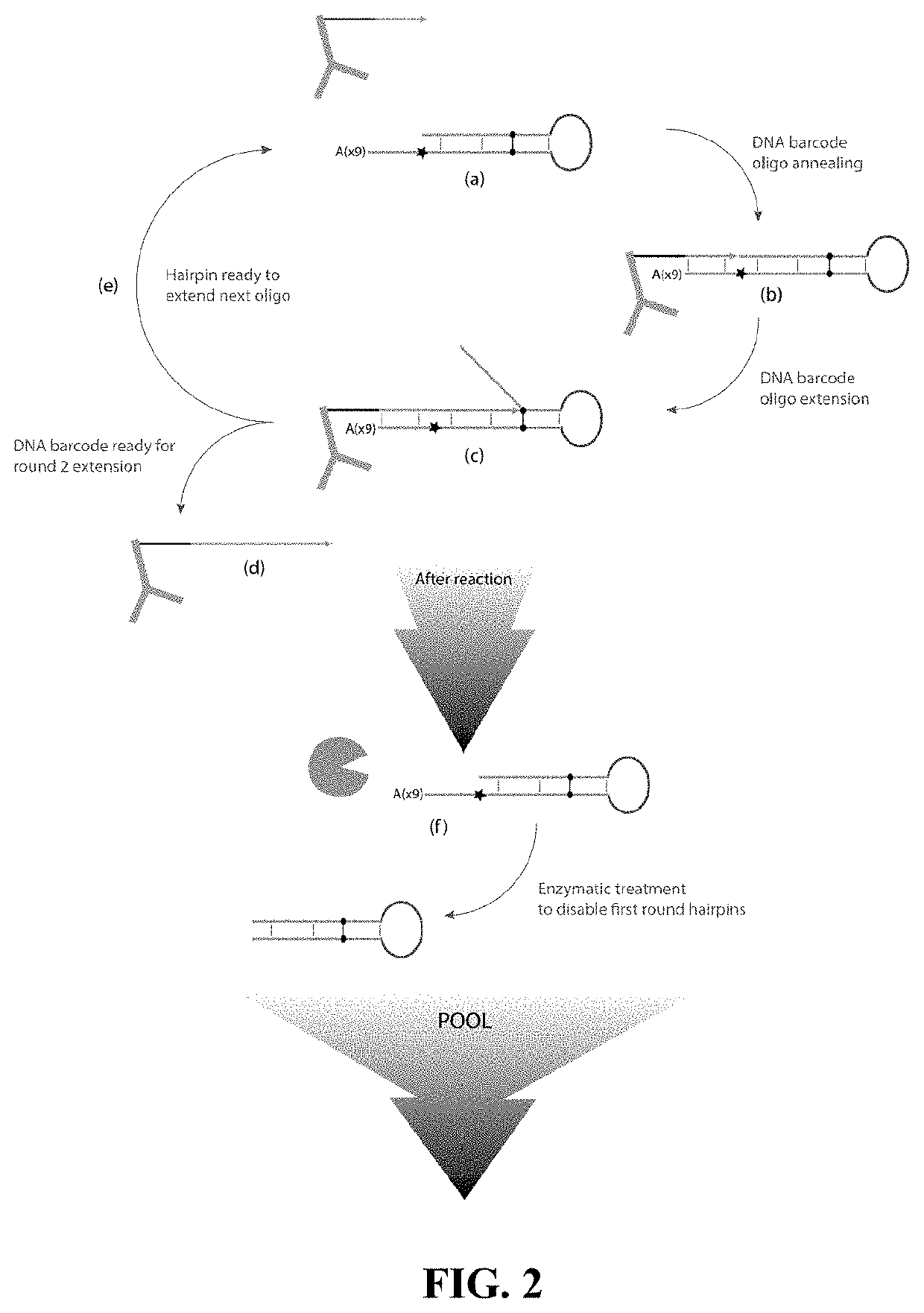Single cell/exosome/vesicle protein profiling
a single cell, exosome technology, applied in the field of single cell/exosome/vesicle protein profiling, can solve the problems of insufficient biological insight, physical invasiveness and time-consuming, biopsies, etc., and achieve the effect of high throughput and cost-effectiveness
- Summary
- Abstract
- Description
- Claims
- Application Information
AI Technical Summary
Benefits of technology
Problems solved by technology
Method used
Image
Examples
example 1
g the Surface Proteome of Single Cells Using DBAs
[0197]This example describes methods of sequencing proteins on cells. However, it is applicable to exosomes and vesicles as well.
[0198]Two cell types (human liver-HEPG2 and human glioblastoma (GBM)-LNZ308) and a panel of 6-8 antibodies specific to each of the two cell types are chosen. The panel of the antibodies are used to demonstrate that a single cell protein quantification method using split-pool sequencing. Liver tissue can be chosen through an analysis of the Human Protein Atlas database (M. Uhlen, et al., Science, 2015). Liver tissue is selected because it exhibits the highest number of tissue specific membrane proteins and because it plays roles in drug metabolism and toxin filtration. A human glioblastoma cell line is chosen because bulk glioblastoma exosomes have previously been shown to allow real time monitoring of GBM therapy (H. Shao, et al., Nature Medicine, 2012).
[0199]Antibodies to these proteins will be procured and...
example 2
g the Proteome of Single Exosomes Using DBAs
[0201]Experiments on exosomes present additional challenges to whole cell experiments. Because exosomes are much smaller, the protein information is much more sparse, it is expected that the number individual exosomes to be processed will be much larger than in traditional single cells experiments-on the scale of tens to hundreds of thousands. Two exosome populations are mixed and are incubated with DBAs for labeling prior to being taken through the split-pool pipeline. It will be confirmed that the tissue origin of each of the exosome is profiled with high accuracy. Specifically, it well be confirmed if the surface proteome profile of individual exosomes correlates well with the surface proteomes of individual cells generated from whole cell profiling.
[0202]Studies have shown high degrees of correlation between cell surface proteome and bulk exosome surface proteome in GBM, colorectal, and B-cell leukemia cell lines (H. Shao, et al., Natu...
example 3
phen Toxicity has a Detectable Phenotype in Cell Culture and can be Similarly Observed at the Bulk Exosome Level
[0204]HepG2 cells are cultured and treated with 1004 to 10 mM of acetaminophen for 24-48 hours (I. Manov, et al., Basic &Clinical Pharmacology &Toxicology, 2004; and R. H. Pierce, et al., Biochemical Pharmacology, 2002). A bulk RNA sequencing analysis is done on both the drug-treated and untreated cell lines as well as exosomes harvested from the media of the drug-treated and untreated cells. In addition, mass spectrometry is performed on drug-treated and untreated HepG2 cells as well as their respective exosome populations to confirm similarity in their protein expression levels under drug stress. It will be confirmed whether these protein changes match already known results in literature a comprehensive list of hits that may be specific to exosomes will be generated.
[0205]It is predicted that some the differentially expressed genes after drug treatment will match hits fo...
PUM
 Login to View More
Login to View More Abstract
Description
Claims
Application Information
 Login to View More
Login to View More - R&D Engineer
- R&D Manager
- IP Professional
- Industry Leading Data Capabilities
- Powerful AI technology
- Patent DNA Extraction
Browse by: Latest US Patents, China's latest patents, Technical Efficacy Thesaurus, Application Domain, Technology Topic, Popular Technical Reports.
© 2024 PatSnap. All rights reserved.Legal|Privacy policy|Modern Slavery Act Transparency Statement|Sitemap|About US| Contact US: help@patsnap.com










